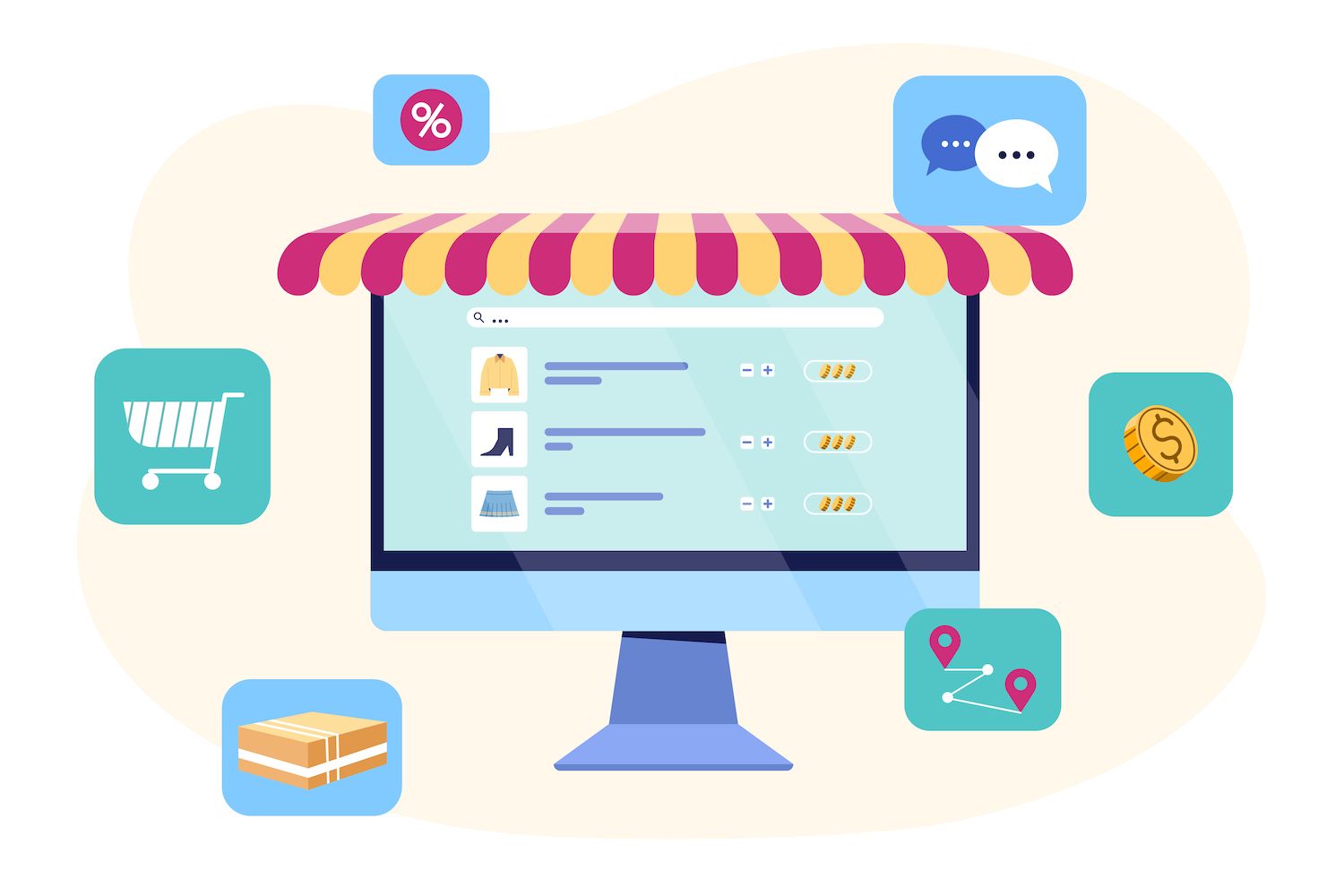eCommerce Shipping Solutions: The Ultimate Guide
If someone clicks on"purchase," or the "purchase" button on your site and they purchase something, you've crossed the line, don't you think? Almost. It's time to streamline your online shipping procedure to maintain your new customers to stay.
Follow this article to figure out the best strategy to delight shoppers all the way through the sales funnel from the moment they add the product they want to buy up to the moment it is delivered to their doorstep.
Shipping fulfillment options for your online store
The process of shipping fulfillment is very complicated. The initial thing you need to consider when establishing your strategy to ship e-commerce is who will be accountable to fulfill the orders. Do you handle them on your own? Will they ship direct from the wholesaler or manufacturer? Or will you contract with a third-party logistics provider (3PL) to manage the fulfillment of all orders placed on your eCommerce?
Let's take a look at the options and walk through the advantages and disadvantages of each.
1. Ship orders yourself
If you're running a small company which produces products on-site, you may find it easier to send your products directly from your offices or storage facility. This is more affordable, especially if you're keeping all your inventory within your own home or office, but it will require more work to maintain.
There are advantages and disadvantages when it comes to handling order shipping to your store's online shop yourself.
Pros of shipping orders yourself:
- You are in complete control of the ecommerce shipping process and are able to customize it according to meet your specific needs.
- It is possible to build relationships with customers by hand-writing thank-you notes, or by including small tokens of appreciation with their purchases.
Cons of shipping orders yourself:
- It can take a long time to ship especially if you are dealing with an abundance of orders.
- You may need to buy shipping materials and equipment, including boxes, labels, and tape.
2. Send orders via Dropshipping services
Instead of buying wholesale items and storing them at your warehouse, while waiting for the orders to arrive You could let your suppliers ship them directly to the client. If your current suppliers don't offer this option You could look for companies that make the same, or comparable items and work with them to send orders directly.

Dropshipping could be an excellent ecommerce shipping fulfillment strategy also for larger companies. Wayfair began its first start as a dropshipping-only firm, and later expanded into using its own warehouses, in addition to still using the dropshipping model. Houzz, a competitor of Wayfair is still using the dropshipping model solely. In the year that ended in June, Houzz made 500 million dollars in sales. Not too shabby for a business that does not design, make, or ship anything that it sells.
Using a dropshipping service is beneficial, but it also has some downsides. Let us discuss the advantages and disadvantages of dropshipping to help you choose the right option for your business.
Pros of dropshipping:
- It's low-cost. You don't need to invest in inventory upfront or to employ staff to run your own shipping operation.
- It is possible to be more flexible in the items you offer. You can easily adjust the products you sell, and you're not tied to a specific inventory. This will give you the ability to quickly adapt to fluctuations in demand.
Pros and cons of dropshipping
- You have less control over the product's quality. When you're Dropshipping, you're trusting the provider to provide quality products. If they do not meet the standards you set, it could be a negative reflection on your company.
- Longer and less reliable delivery times can be troublesome for your customers, and could result in reduced sales. Because you're relying on an outside company to manage shipping, there's always the possibility of delays. If you're working with multiple dropshipping services, items within an order may be delivered in different boxes at different times, which can lead to customer confusion and increased the number of customer support calls.
- The shipping issues may require more time to address. When you ship products yourself or work with a 3PL business, you'll be able to handle customer service concerns more quickly. If you're using multiple dropshipping businesses, you may be experiencing delays in communication which increase the length of time required to address the issue of a complaint from a client.
3. Send orders using a third-party logistics (3PL) service
If you're a business that orders multiple products from manufacturers, but don't have the time, money, or the resources needed to manage the warehousing yourself it is possible to contract an outside logistics company for all of your online shipping.
This can be a good option if you do not possess the space for storage or the capability of shipping yourself However, this can be costly for smaller businesses, depending on the volume you average for sales.
A few pros and cons of making use of 3PL fulfillment services include: 3PL fulfillment service comprise:
Pros of making use of a 3PL serviceare:
- A fulfillment service can handle the entire shipping process to you, from packaging, tracking and delivery.
- Many of them have partnerships with large carriers. This could save you money on cost of shipping.
- They are able to scale quickly to accommodate spikes in demand.
- It is not necessary to employ your own staff to manage shipping and fulfillment, which helps you cut down on time the management tasks.
- It is not necessary to store the inventory at your office or home. This could reduce the cost of overhead and keep your work environment less cluttered.
Cons of the use of 3PL services: 3PL services:
- You will have less control in the delivery process and you may not be able customize the process to meet your requirements.
- You may need to pay a monthly or per-order fee in addition to shipping costs.
- Certain customers might prefer to deal directly with the retailer instead of dealing with a third party.
The final decision on which is best for you - self-sending via dropshipping, using a dropshipping provider, or working with an 3PL is contingent on several variables that go beyond the ones we've mentioned in the previous paragraphs. It's important to consider the advantages and disadvantages of each alternative. At the end of the day you could even settle to combine a variety of fulfillment solutions. There is no need to choose just one!
Shipping carriers and methods
Whichever fulfillment solution you select, you'll have to be familiar with the different shipping companies and techniques, since you'll need to add information about the different shipping methods into your store's shipping settings. It is also necessary to give information about your carriers and shipping methods to your customers - especially if you're giving them multiple choices during the checkout.
A shipping carrieris the firm that physically delivers your products to your customers. Examples include USPS, FedEx, UPS, and DHL.
Shipping methods are the choices and prices that buyers select at the point of purchase - like free ground shipping, $5.00 three-day shipping, or $15.00 next-day delivery. These options are generally chosen by the companies you work with and impact both the cost as well as the speed of delivery.
Consider dates, places, and weighs
Prior to deciding your shipping carriers and methods, think through some of the most important factors to consider:
- Places. What countries, states, or provinces can you send your cargo to?
- Dates. When you think about where your customers reside and the time it will time be for a particular country, state, or province? Are you interested in offering express shipping?
- Weights. The weight and size of every item affects the overall cost of shipping.
Places: Decide which countries to send your parcels to
There are several points to take into consideration when looking to determine which countries your ecommerce store should serve. The first is to think about the markets your customers are within. If your products would be very popular with consumers in the United States, then it is sensible to deliver to the United States. However, if you're selling items which are niche or targeted towards a particular area, you may prefer to restrict your delivery exclusively to the region in question.
A second thing to think about is the price of shipping. International shipping can be expensive and you'll have to consider that in your selection. You may also need be aware of customs requirements as well as other rules, which can add even additional complexity and expense.
Also, consider whether you've got the capacity to handle shipping to different nations. It's a lot of work to deal with various shipping rules, carriers alternatives, rates and options So make sure that you're ready for this prior to making the decision.
If you take all these aspects into consideration and take into account all of these factors, you'll be able to narrow down the list of countries to ship to. From there, you can start researching the specific rules and regulations for every country, to ensure you're prepared to ship there with ease.
Pro-tip:Beyond extra expenses and logistical challenges International shipping is a challenge because it has the legal requirements and regulations for customs that can vary dramatically by country and region. Be sure to partner in a shipping company which can streamline every step of the process as possible.

Shipping is now partnering with DHL So now you can manage international orders right from your own dashboard. Additionally, you can save as much as 67% off labels, enjoy free pick-ups and be able to offer customers with end-to-end tracking as well as automated customs forms creation.
Dates: Determine delivery times, carrier, and methods
Decide on delivery times and delivery methods for your online store to best suit your business. You'll need to choose an option that will deliver your items to customers in a timely manner. If you're selling products that need to be delivered quickly, such as cosmetics or food items, this is even more crucial.
Depending on where you're shipping to and the time it takes for your goods to arrive You may provide one or multiple ecommerce shipping options like:
- Standard Shipping: UPS Ground, 1-5 business days
- Expedited Shipping: USPS Priority Mail within 1-3 business days.
- For Overnight Delivery: FedEx Priority Overnight 1 business day
If you can provide fast and secure shippingservices, you can guarantee that your customers will be happy with their experience.
Size and weight could impact shipping costs and shipping options.
When you begin shipping products, it's important to understand not only the dimensions and weights of your products, but their weight and size after they've been wrapped. This can help you determine the best method for each item or order that's shipped.
If you're a business that ships to shipping to the United States, the least cost method to send small items is typically USPS Priority Mail 3 Day Small Flat Rate Envelope or Small Flat Rate Box. It provides tracking and fast delivery times, and it's a particularly good bargain if you're shipping tiny however heavy goods. You can ship something as heavy as 70lbs and pay the same flat rate. Also, you can avail the benefits of USPS giving you an envelope with a flat rate or box.
When you're sending large items, oversized package fees are not a must, however, If you're shipping multiple items in an order it may be more cost effective to split these items over several packages to avoid oversized costs for packaging.
The 3PL service will default to any method that's most economical for them and for your business. If you need items to arrive in the same package, even if it's more expensive, or if you want to divide things in multiple packages due to reasons that make it have been cheaper to pack them in one larger box, you'll need notify your 3PL that they should follow your procedures. If you're packing and shipping things yourself, you have more complete and granular control over the process.
For international shipping You'll have take a look at the choices that are available for the different countries and figure out what is the most efficient depending on the dimensions and weight of your products. While strategies like splitting up products to reduce the cost of shipping can be helpful for domestic shipping however, this strategy may not be effective for international deliveries. You'll need to map out the specific ecommerce shipping method to each country that you send your shipments to.
How to package orders for shipment
Destination, size and weight, the carrier and shipping methods all influence the shipping cost and methods you use. It is equally crucial to consider the manner in which your packages are packed. As a business proprietor, you must ship products efficiently and in a cost-effective method while also ensuring that your items are delivered in good order.
If products are packed poorly, you can end up with poor reviews, return as well as costly order reshipments. When you ship products by yourself, employing an 3PL service, or dropshipping direct from your supplier Make sure all of products are packed safely and securely.
You'll want to consider how many items can fit in a single package and whether different types of products should be shipped together or separately. You'll also want to make sure your products are protected from the elements and from the damage caused by dropping, stacking, and agitation during transport.
Ask yourself the following questions regarding your items for the best way to pack them:
- Is it too heavy?
- Do you think it is fragile?
- Are they sharp?
- Do they contain fluids?
- Is it one-of-a-kind?
- Could it be damaged easily if it gets wet?
- Do you think it's too large?
- Does it seem tiny?
If a customer orders two different items - like a pair of champagne flutes made from crystal and a set of free weights You probably won't wish to put them all in the same box. However, even if a customer orders several of the same thing, you may still want to break the order up in several packages to minimize harm.
If, for instance, someone buys twenty 18" 24" canvas prints from the store, it would not be prudent to put them all in the same package. The weight of each item may create damages to the canvas beneath it. In addition, you might be charged more for shipping for using an oversized box.
The bigger and more unwieldy the box is, the harder it will be to get it delivered without being dropped. Its notable size may also draw the attention of package thieves.
The small size of packages can pose a challenge too. Even if your item could be placed in a compact padded envelope, you may have to include a strong cardboard or hardboard insert to keep it from bending or bending. You can also use bubble wrap or any other padding to ensure that your goods arrive in a safe manner at the destination of the buyer.
If you've got a mixture of large and small things in an order it is possible to ship them all together in the event that the smaller items actually function as padding (like clothing or linens) or are lightweight and long-lasting.
Choosing the right packing materials
Packaging materials that are suitable for large and small packages can increase your ecommerce shipping costs. You don't just have pay for the cost to purchase these materials, but they also increase the weight of your package, which could raise shipping costs.
There's a need to be sure that your boxes and packaging materials are able to handle the size and weight of the things you're shipping however that's not all you need to consider.
In selecting the materials you will use to pack your online orders, think about these aspects:
- The fragility of the item
- Experience with brands
- Eco-friendly materials
- Cost of packaging
Fragile merchandise
If you're shipping items that are fragile, you'll need to use different packaging materials than when the items are not fragile. There may be additional bags of bubble wrap or air cushions to ensure your items arrive safely. The addition of packing materials can increase your overall package size But ensuring your items are delivered safely can reduce the cost of returns in the long run.
Be aware of the possibility that your products will be damaged by water or other elements during shipping. Consider wrapping products that could be damaged by water using shrinkwrap, a plastic overbag or any other type of waterproof packaging. If you're using a balloon mailer, you should choose a plastic one instead of a paper one.
Brand experience
If you aren't bothered by cost it is possible to brand the packaging materials you use. Businesses like Sticker Mule provide custom-branded packaging and tape that you can use to make all of the shipments you receive from your orders to be branded.
When a box that has your company's logo is delivered to someone's door the recipient will know that it's coming from the company. Seeing your brand can add a little more excitement to an individual's day. Additionally, the fact that your business is willing to go the extra mile to package its products will help build confidence that you're making the same energy into your product.

Organic materials
If you're looking for your business to use environmentally sustainable packaging materials, there are definitely solutions available. You may even use eco-friendly packing materials as part of your marketing strategy. If you're selling items that are nature-related, organic, or you simply value environmentally-friendly manufacturing methods It could be beneficial to invest in eco-friendly packaging.
Companies such as Hero Packaging, Mushroom Packaging as well as Noissue offer sustainable packaging options. Noissue even offers personalized branding for your packaging materials. Environmentally friendly packaging is sometimes more expensive than other materials So keep this in your mind when you're working on a tight budget.
Cost of packaging
You'll want to ensure your goods are delivered securely and that your customer has a positive experience with your delivery. But you also don't want to spend too much on packaging.
With this in mind With these considerations in mind, let's take a closer review of some of the most popularand cost-effective shipping materials and how they can benefit your ecommerce company.
Cardsboard containers are one of the most frequently used packaging materials for ecommerce orders. They're durable and strong and are perfect for protecting fragile items. The cardboard boxes are lightweight, so they won't add a lot of extra weight to your shipping costs. Additionally, cardboard can be recycled, which means it's a great option for businesses that are environmentally conscious.
It's possible to purchase cardboard made from recycled materials in the beginning. Most packaging retailers like Uline sell environmentally-friendly cardboard boxes.
The bubble wrap is yet another option for packing material. It's ideal for protecting delicate objects and also preventing damages during shipping. Bubble wrap comes in different thicknesses, so you can pick the best amount of protection to your items. Like cardboard boxes, bubble wrap is cheap and recyclable.
Peanuts for packing are commonly used to fill empty space in packages and prevent items from shifting during shipping. They're made from different materials which include biodegradable ones like cornstarch. Packing peanuts can be reused and are a great alternative for companies looking to minimize their impact on the environment.
Air cushions are a viable alternative for packing peanuts. They're inflatable bags that can be used as filler inside packaging. Air cushions offer the same security as packing peanuts but are easier to reuse and recycle.
Paper is a different eco-friendly packaging product. Paper can be used to cushion fragile items or fill empty space in packaging. Paper is also recyclable (and it is possible to use papers that is made of recycled materials) This makes it a great option for businesses that seek to minimize their environmental impact.
There are numerous packaging materials to choose from, and it's crucial to pick the best option to suit your needs. Take into consideration your the shipping requirements, as well as your brand image when selecting packing materials to ship your online orders. With the right materials, you can ensure that your goods arrive safe at their destination while making an impact on your clients and having minimal effect on the planet.
Decide on your rates of shipping for your customers
Once you've identified the location you're shipping to, what you're packaging, what techniques and shipping methods you're using as well as the impact of weight and size on the options for shipping, you'll need to calculate two aspects: your costs for shipping and handling as well as the rates for shipping the company charges its customers.
You can also use a shipping calculator at any of the top carriers' websites or a multi-carrier shipping software to calculate ecommerce shipping costs depending on the method used of shipping, the size, weight and the destination The calculators won't include handling costs.
It's up to you to decide what works most effectively for your company, nevertheless, you'll need to put these handling costs to a place to ensure they do not eat away at your profit margins.
What are the costs for handling?
Handling is everything but the shipping cost that the carrier charges you. Handling may include however, it isn't limited to:
- Cost of shipping supplies like boxes, padding materials back boards, plastic sleeves, tape, labels, and thermal printer.
- Cost of storage for inventory.
- Time spent packing orders and arranging the pickup of carriers.
- Customer service regarding damaged or lost packages, and updating customers about the progress of their deliveries.
One way to estimate your handling costs per purchase is to figure out how much you'll spend each month for these costs, and divide it by the amount of monthly orders. Add that handling fee to the cost of shipping each order.
If you'd like to incorporate the cost of handling into your product prices then you can divide your handling costs for the month by the amount of merchandise sold in a month. If you sell high-priced items and low-priced products it is possible to distribute your handling costs. Cheaper products will likely be less expensive to handle with them than more expensive products, although this isn't always the case.
How can I best approach formulating shipping costs?

Live rates
Table rates
Flat rate
Flat rates streamline your shipping strategy by taking the guesswork out calculation of rates. Charge the same amount regardless of the weight or size of your order. This can be a good alternative if your inventory has a consistent dimensions and weight, or if a majority of your clients order the same quantity. By using default settings, you can offer a flat fee per item, or a percent-based price, or a minimum fee.
Free shipping
Customers who receive free shipping are content, however it reduces your margins. It is possible to include the costs of shipping into the price of your product, however people might not be impressed because of the price. Keep your prices low and shipping free, with the hopes that sales growth can make it profitable financially.
Combination shipping
The combination of shipping options offers two options. If a one-size-fits-all approach to shipping doesn't align with the needs of your company, you can always combine and mix and match. One approach is to offer free shipping on orders that have a minimum value in order to convince customers to purchase more products to their carts.
Implement your ecommerce shipping strategy
Once you've done your research, weighed your options, and made a decision, you're ready to put your plan in position and begin setting up the ecommerce shipping process.
1. Make sure you back up your store
If your shop is currently live and you want to make an all-encompassing backup. When unexpected problems arise, this ensures you don't loss important information and the information about orders. We suggest Jetpack VaultPress Backup to handle this.
When your backup has been completed After your backup is complete, you should make sure to update WordPress as well as your theme, and all plugins to ensure full support for any updates to fulfillment and shipping extensions.
2. Setup settings

Click on the Settings tab - Navigate to Settings - Shipping on the dashboard. You can then create shipping zones to define rates based on customer locations, and shipping categories for defining rates based on the same products in a group.
Let's take into consideration shipping zones. When you set these up, you'll have the ability to set shipping charges based upon the particular areas that you ship to. And you can either be pretty generic here (like setting rates by country) or be hyper-specific (like defining rates by the zip code). Do not worry about it - regardless of the level of complexity the individual customers will only see the rates which apply to their particular shipping address.
Select the shipping zonestab and in the event that you're still not setting up a zone yet, you'll see a prompt to create one.

Click Add shipping zone.

When the new window appears, you can name the zone however you'd like to. Select your shipping regions that will be part of this zone. There are a variety of ways to configure zones. Take your time to think of the best way to do so to benefit your company.
A retail shop situated inside New York City might have areas for areas like the East Coast, Midwest, and West Coast, with rates increasing in price based on the distance to New York. For example, a bakery may offer free shipping just within their area, and paid rates to any other location.
Pick all of the places you'd like included in this zone of shipping. If you want to limit your zone according to zip code, simply click Limit to specific zip codes or postcodes. A new form will be displayed that allows you to enter the zip code in a list.
In the next step, you'll need to determine the shipping costs which are applicable to the new zone. Simply click the Add shipping rate button. By default, you'll see three options: flat rate, no-cost shipping and local pickup.
If you select Flat rate shipping,you'll have the option to set a specific price for that area (e.g. $9.99 flat rate shipping). The option to change this is depending on the type of shipping you use, which we'll talk about later.

If you select Free shipping, you can set the minimum amount of your order to qualify for free shipping. You can also choose regardless of whether you wish to include free shipping in a coupon code, and other.

If you choose to go with Local pickup,customers that reside within the shipping area are able to collect their package at your place of business.

Remember, you can make one or more the items listed above to every zone. For instance it is possible to provide free shipping over an amount specified in the order, and flat rate shipping for all other items that are less than this total.
But what about shipping classes? While these aren't required but they can be a great way to set rates for various types of merchandise. You could, for instance, sell unframed prints of your work, as well as frames. Not only will these be priced differently to ship depending on the weight of your items, but framing options also need additional packaging material.
Let's look at this scenario. Within your dashboard, you would browse to - Settings - Shipping Then, click on to open the Shipping Class tab. Click "Add new shipping classes" on the right-hand area of the page.
After that, you can add the class's name, name, Slug (URL) along with a description, and click Save shipping classes.
You'll need to assign products to each category you've made. Go to Products - All Productsand open the that you'd like to change. Scroll down until the product data box and choose the Shippingtab.
In the dropdown in the dropdown for Shipping class,select the class that most closely matches the item. Save your adjustments. It is possible to do this for each product in that category. Save your changes.
It allows you to be much more precise with your shipping rates. So, for example when you're setting up flat rate shipping, you can set an additional price for frames as opposed to. non-framed prints. In the image below that there's an additional option for"framed" shipping classes "framed" shipping type.
That's all there is! You can see that there's lots you can accomplish with default settings for shipping.
3. Install and activate shipping extensions
For table rates as well as live rates, or to make use of a mix, you'll need an extension. You can also use extensions to include features such as shipping labels and warehouse syncing.
Working using the 3PL service? There may be an extension available in the marketplace or directly through their website and they can also set up a custom integration for you.
4. Make it easy for customers to comprehend where they placed their order
The process of shipping your order online isn't over once you've dropped the package off. Indeed, many of the most rewarding opportunities for good customer service occur when your purchase is placed in the mail!
Customers must be able to quickly know where their order is in all time and what time it will take to arrive. This is crucial if your products often are purchased for gifts.
5. Think about returning shipments
Though nobody wants to think about returns, they do occur. When you are able to exchange or return shipments, it's important to have a system that is in place.
Profit and Ship!
It's time to begin shipping! Be sure to adjust your strategy for shipping in the course of time and make modifications as you discover more about your clients, and you'll quickly discover the solutions which are beneficial to customer relations and the bottom line.
There are a variety of methods to deal with ecommerce shipping. You can do it yourself or partner with a logistics firm and drop ship items directly from the manufacturer. In order to make the right choices, you'll need to consider, in part, which companies are readily available for each option and if they are able to meet the needs of your business.
Certain shipping companies on the internet have restrictions on the items they'll send, like, or special regulations for certain kinds of materials. And if you want to send your goods internationally, it's important locate a company that is able to reach the regions you'd like to focus on.
It is possible to pass on the cost of shipping to your clients, or pay for all or a part of it your own. There's pros and cons with each method and you may want to experiment over time. If you do choose to charge for shipping, you can set rates in an array of options ranging starting with flat rates, table rates and even live, real-time pricing that is sourced from the shipping company.
And, regardless of what you decide to do when setting up your eCommerce shipping plan It has the right tools to handle it all. Make use of extensions that allow you for shipping products cheaply, efficiently, and safely so your happy customers stay content and your shop runs smoothly. Need more information? Take a look at our online shipping documents.
